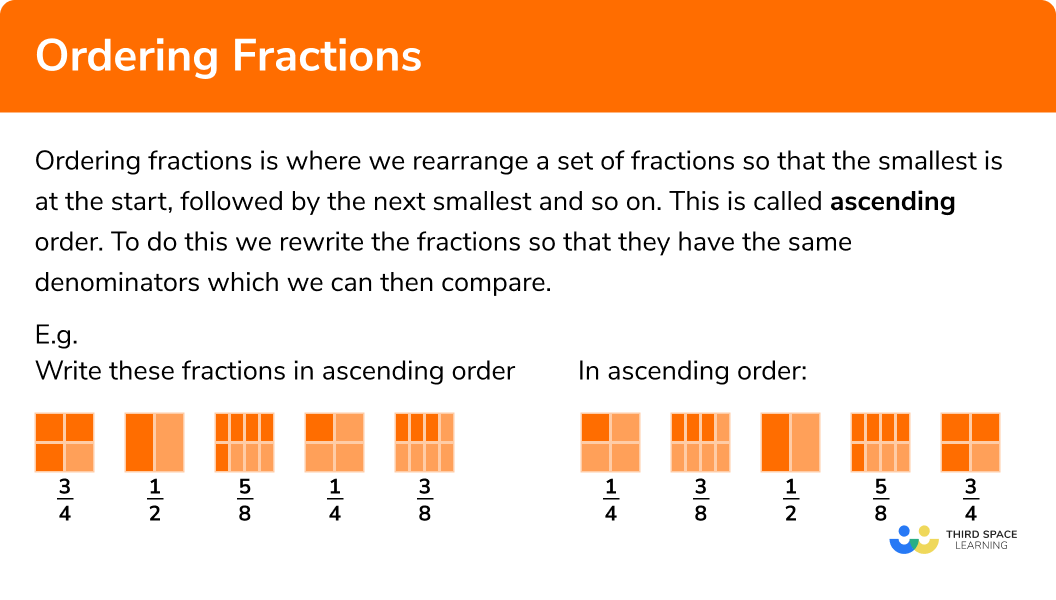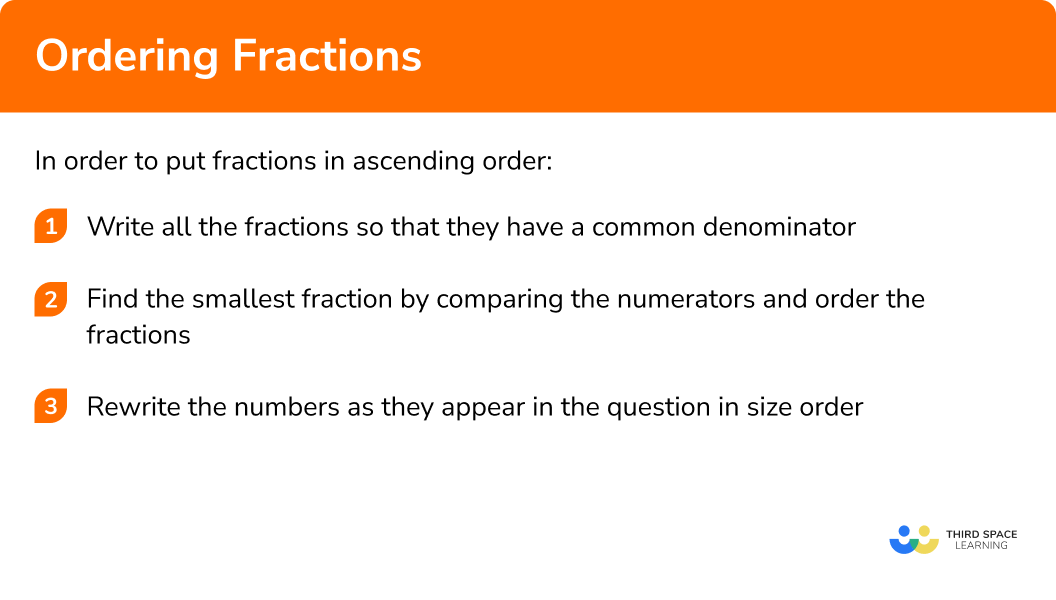GCSE Tutoring Programme
"Our chosen students improved 1.19 of a grade on average - 0.45 more than those who didn't have the tutoring."
In order to access this I need to be confident with:
Place value Equivalent fractions Improper fractions and mixed numbers Fractions to decimalsThis topic is relevant for:

Ordering Fractions
Here we will learn about ordering fractions.
There are also ordering fractions worksheets based on Edexcel, AQA and OCR exam questions, along with further guidance on where to go next if you’re still stuck.
What is ordering fractions?
Ordering fractions is where we rearrange a set of fractions so that the smallest is at the start, followed by the next smallest and so on. This is called ascending order.
To do this we rewrite the fractions so that they have the same denominators which we can then compare.
We can order any type of fraction including proper fractions, improper fractions and mixed numbers.
E.g.
Write these fractions in ascending order:
In ascending order:
What is ordering fractions?

How to order fractions
In order to put fractions in ascending order:
- Write all the fractions so that they have a common denominator
- Find the smallest fraction by comparing the numerators and order the fractions
- Rewrite the numbers as they appear in the question in size order
Explain how to put fractions in ascending order in 3 steps


Ordering fractions worksheet

Get your free ordering fractions worksheet of 20+ questions and answers. Includes reasoning and applied questions.
DOWNLOAD FREE
Ordering fractions worksheet

Get your free ordering fractions worksheet of 20+ questions and answers. Includes reasoning and applied questions.
DOWNLOAD FREERelated lessons on fractions
Ordering fractions is part of our series of lessons to support revision on fractions. You may find it helpful to start with the main fractions lesson for a summary of what to expect, or use the step by step guides below for further detail on individual topics. Other lessons in this series include:
Ordering fractions examples
Example 1: ordering proper fractions (with different denominators)
Write the following fractions in order of size:
- Write all the fractions so that they have a common denominator
The fractions have different denominators.
The denominators of the fractions are
The lowest common multiple is
2Find the smallest fraction by comparing the numerators and order the fractions
Here are the fractions with their common denominator of
Writing them in size order would give
3Rewrite the numbers as they appear in the question in size order
Example 2: ordering proper fractions (with different denominators)
Write the following fractions in order of size:
Write all the fractions so that they have a common denominator
The fractions have different denominators.
The denominators of the fractions are
The lowest common multiple is
Find the smallest fraction by comparing the numerators and order the fractions
Here are the fractions with their common denominator of
Writing them in size order would give
Rewrite the numbers as they appear in the question in size order
Example 3: ordering improper fractions and mixed numbers
Write the following fractions in order of size:
Write all the fractions so that they have a common denominator
We can either write all the fractions as improper fractions or as mixed numbers. It is simpler to write them as mixed numbers and concentrate on the fractional part of the mixed number.
The fractions have different denominators.
The denominators of the fractions are
The lowest common multiple is
Find the smallest fraction by comparing the numerators and order the fractions
Here are the fractions with their common denominator of
Writing them in size order would give
Rewrite the numbers as they appear in the question in size order
Example 4: ordering improper fractions and mixed numbers
Write the following fractions in order of size:
Write all the fractions so that they have a common denominator
We can either write all the fractions as improper fractions or as mixed numbers. It is simpler to write them as mixed numbers and concentrate on the fractional part of the mixed number.
The fractions have different denominators.
The denominators of the fractions are
The lowest common multiple is
Find the smallest fraction by comparing the numerators and order the fractions
Here are the fractions with their common denominator of
Writing them in size order would give
Rewrite the numbers as they appear in the question in size order
Example 5: ordering fractions and decimals
Write the following fractions in order of size:
Write all the fractions so that they have a common denominator
When there is a mixture of decimals and fractions it is sometimes easier to write them all as decimals. Some fractions and their decimal equivalents may be well known, otherwise we may need to work out a division.
Find the smallest fraction by comparing the numerators and order the fractions
Here are the numbers as decimals. To help with comparing it is a good idea to put in a zero in the hundredths column for
Writing them in size order would give
Rewrite the numbers as they appear in the question in size order
Example 6: ordering fractions and decimals
Write the following numbers in order of size:
Write all the fractions so that they have a common denominator
When there is a mixture of decimals and fractions it is sometimes easier to write them all as decimal fractions (decimals). Some fractions and their decimal equivalents may be well known, otherwise we may need to work out a division.
Find the smallest fraction by comparing the numerators and order the fractions
Here are the numbers as decimals. To help with comparing it is a good idea to put in a zero in the thousandths column for
Writing them in size order would give
Rewrite the numbers as they appear in the question in size order
Common misconceptions
- Changing the numbers into the same type of fractions
It is much easier to change the fractions so that they have a common denominator and then compare the numerators.
- Use decimals if the common denominator is too tricky to find
Sometimes finding a common denominator can be very difficult so it can be easier to convert the fractions to decimals and compare them instead.
- Smallest to largest or largest to smallest?
Usually “in size order” means from smallest to largest. But the question might want you to put the numbers in descending order from largest to smallest.
E.g.
Write these numbers in order of size from largest to smallest:
Convert the fractions so they have the same denominator:
Write the fractions in order of size from largest to smallest:
The final answer is:
Students can also explore some online ordering fractions calculators to sort from ascending to descending.
Practice ordering fractions questions
1. Write these numbers in order of size:
\frac{5}{6} \quad \quad \frac{2}{3} \quad \quad \frac{1}{2} \quad \quad \frac{5}{12}




2. Write these numbers in order of size:
\frac{5}{8} \quad \quad \frac{3}{4} \quad \quad \frac{13}{24} \quad \quad \frac{7}{12}




3. Write these numbers in order of size:
1\frac{2}{5} \quad \quad \frac{19}{15} \quad \quad 1\frac{11}{30} \quad \quad \frac{7}{6}




4. Write these numbers in order of size:
3\frac{7}{10} \quad \quad \frac{17}{5} \quad \quad 3\frac{3}{4} \quad \quad \frac{67}{20}




5. Write these numbers in order of size:
\frac{1}{4} \quad \quad 0.2 \quad \quad \frac{1}{2} \quad \quad 0.3




6. Write these numbers in order of size:
0.82 \quad \quad \frac{4}{5} \quad \quad 0.71 \quad \quad \frac{3}{4}




Ordering fractions GCSE questions
1. Here are four fractions:
\frac{17}{20} \quad \quad \frac{7}{10} \quad \quad \frac{3}{4} \quad \quad \frac{3}{5}
Write the fractions in order of size.
Starting with the smallest fraction.
(2 Marks)
(1)
\frac{3}{5} \quad \quad \frac{7}{10} \quad \quad \frac{3}{4} \quad \quad \frac{17}{20}
(1)
2. Here are four fractions:
\frac{2}{5} \quad \quad \frac{1}{4}\quad \quad \frac{4}{13}\quad \quad \frac{3}{10}
Write the fractions in order of size.
Starting with the smallest fraction.
(2 Marks)
(1)
\frac{1}{4}\quad \quad \frac{3}{10}\quad \quad \frac{4}{13}\quad \quad \frac{2}{5}
(1)
3. Place the following numbers in order of size, smallest first:
2\frac{1}{4} \quad \quad 1.76^2 \quad \quad 2.14 \quad \quad \frac{17}{6}
(2 Marks)
(1)
2.14 \quad \quad 2\frac{1}{4} \quad \quad \frac{17}{6} \quad \quad 1.76^2
(1)
Learning checklist
You have now learned how to:
-
Write fractions in order of size
The next lessons are
Still stuck?
Prepare your KS4 students for maths GCSEs success with Third Space Learning. Weekly online one to one GCSE maths revision lessons delivered by expert maths tutors.

Find out more about our GCSE maths tuition programme.